The 2017 Fyre Festival was advertised as a luxurious Bahamian get-away, with incredible music and scenic views. The reality of the festival was dirty, barbaric, and fraudulent.
T.R. Todd, a Canadian journalist and author, witnessed the chaos of Fyre Festival first-hand while working in Exuma, Bahamas at the time of the event. He practiced public relations and marketing for Grande Isle Resort: an upscale destination in Exuma.
Having organized events such as marathons and music festivals on Great Exuma, Todd understood how much time it takes to execute these events. From the beginning, he believed that it would be physically and logistically impossible for Fyre Festival to be successfully executed in the time that the company had.
“A cautionary tale,” said Todd when referring to Fyre Festival. The event has sparked many conversations regarding the contemporary practice of public relations. This case demonstrates the consequences of failing to be transparent with consumers.
A documentary about Fyre Festival, FYRE: The Greatest Party That Never Happened, was released on Netflix in April 2019. The film provides direct insight from Fyre employees and unfortunate attendees. It shows the truth behind the lavish Instagram posts and the bright smile of Billy McFarland: the CEO of Fyre, a music talent booking app.
The festival gained incredible exposure due to the viral promotional video. In it you see models on yachts, McFarland and fellow business partner ‘Ja Rule’, gorgeous blue waters, and of course the private island once owned by Pablo Escobar.
Fyre asked influencers to help promote the festival by posting the viral ‘orange tile’ photo on their social media platforms. According to the documentary, supermodel Kendall Jenner was paid $250,000 dollars to post the photo.

As the event approached, attendees started asking questions and voicing concerns on Fyre’s social media platforms. Fyre responded by disabling comment sections and providing no response to the public.
Fyre Festival completely failed to meet the lavish expectations that they ingrained in attendees’ minds. What were promoted as luxurious cabanas were, in reality, leftover Hurricane Matthew disaster tents. The advertised five-star cuisine was bread with a cheese slice.
Additionally, the private island was not private. In fact, it wasn’t even the original island promoted in the video. Fyre could no longer host the event on Pablo Escobar’s island due to legal action, therefore they relocated to a non-secluded location in Great Exuma. This was never communicated to the public.
Lacking resources, attendees developed a looting-like mentality, grabbing whatever they could. The festival was shut down days before intended – leaving many attendees stranded due to the lack of available charter flights.
Fyre clearly withheld excessive amounts of information from the public, even when they knew that they would not be able to deliver what was promised in their advertisements.
“I think it’s a lesson, certainly in public relations, that you can’t suppress information to the point where it’s just truly ridiculous,” said Todd.
Todd explained that from a public relations perspective, the two realistic options for handling the situation would have been to either carry on with the festival, while being completely honest, or to postpone the festival to a later date.
In the documentary, music festival consultant Marc Weinstein explained his proposal to McFarland and Chief Marketing Officer Grant Margolin, attempting to avoid a public relations crisis. His plan greatly resembled that of Todd’s. Ultimately, these efforts to prevent a crisis were ignored.
Maryann Rolle, a Bahamian restaurant owner, is one of many workers who have been financially burdened by the festival. She was forced to use her life savings to pay unpaid workers. A GoFundMe has been created to raise money for Rolle and has already exceeded the amount lost.
In March 2018, McFarland was sentenced to six years in federal prison on charges of fraud. McFarland was found guilty of falsifying numbers in an effort to continually obtain money from investors and of allowing a festival to take place that disrupted the lives of many. Fyre employees are still dealing with guilt.
For someone entering the field of communications, they can learn immensely from this affair. Todd shared what he believes are three key take-aways from Fyre Festival:
1. This case demonstrates how individuals must be responsible with the messages that they broadcast online. We saw how easily the event was promoted on social media, yet failed to be executed.
2. When you realize that you cannot deliver an original promise, it is vital to be honest with the consumer to manage expectations.
3. There is a saying that “no publicity, is bad publicity,” said Todd. The festival was a disastrous inconvenience for Great Exuma. But, the publicity of Fyre Festival has let millions of new eyes see Exuma’s natural beauty and possibly add it to their list of dream destinations.
This infamous event teaches those entering the communications field that failing to practice transparency with your audience can lead to devastating results.





